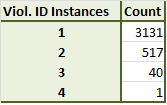Surveying Unassessed Waters in PA
According to the Pennsylvania Fish and Boat Commission (PFBC), only 22,000 of the 86,000 miles of flowing water in PA have been sampled by biologists from their organization. As of 2011, about 12,800 miles were designated as wild trout waters. (It is hard to believe that we have so many streams to begin with!) In recent years, many groups in the Commonwealth have increased their efforts to assess these streams due to increases in potential water quality threats, such as land development and unconventional natural gas extraction. By default, unassessed streams are given the lowest classification category by the PA Department of Environmental Protection (PA DEP). It is important to prioritize streams according to their water quality, the potential for wild trout populations, and the risk posed by nearby human activities. Why trout? Glad you asked. While there are many other ways to determine water quality, the presence of wild trout increases the streams’ water quality protection classification in PA.
A few weeks ago I spoke with an engaging gentleman from Susquehanna University, Dr. Jonathan Niles, who is working on a unique stream sampling project through the PFBC with a number of partners to do just that. Pennsylvania’s Unassessed Waters Initiative seeks to classify the 92% of streams that don’t have monitoring data about. In 2010, PFBC partnered with two universities to survey trout populations in 30 streams each under a small grant. This work was expanded in 2011 with even more entities signing on, including Susquehanna University, and resulted in a significant increase in the number of classified streams. The project involves entering the GPS locations of the unassessed streams and then collecting trout population data from the field. In the past two years the Unassessed Waters Initiative has surveyed 1,049 streams and documented wild trout in about 55% of those streams. Check out the progress they have made in the two maps below, the first from 2008 before sampling efforts were increased, and the second from 2012:
In addition to the sampling protocol set forth by PFBC, Dr. Niles and his students Caleb Currens, John Panas, and Sam Silknetter collected benthic macroinvertibrate (which are PA DEP water quality indicators) and algae species data, conducted fish population estimates on every stream (not just where there was more than 5 fish of a certain species), sampled fish diets, and collected water for additional heavy metals and contaminant analysis. The preliminary fishery data from last year are currently being reviewed by the PADEP.
Some of the Initative’s efforts have focused on the quality of streams near shale gas drilling operations, especially due to the risk that erosion and sedimentation poses to trout’s habitat. Dr. Niles feels that the data collected from initiatives like this one provide valuable operating insight for development and natural gas companies, as sensitive areas can be avoided by companies – saving them time and money.
With funding from the National Fish and Wildlife Foundation, the Iinitiative has been funded again this year. Dr. Niles’ team is contracted to assess 20 streams in Loyalstock that were previously unassessed. An additional 40 streams will be assessed by Dr. Niles’ team elsewhere in PA. While they have made extraordinary progress, there is still much work to be done. What does a project with such a broad geographic scope like this one cost? In addition to travel and salary costs, each benthic macroinvertebrate sample runs about $200-250 to analyze in a lab. It is likely that this year alone there will be at least 60 samples collected by Dr. Niles’ team, if not more. The financial cost of conducting this kind of research may seem high, but the failure to do so could cost Pennsylvanians much more. It is our hope, here at FracTracker, to keep up-to-date with the Unassessed Waters Initiative as the teams go out this year. Check back soon for more information, or contact us if you would like to get involved with either the sampling or funding of this initiative: info@fractracker.org.
Below are photos of Dr. Niles’ assessment team taken during their field sampling trips.
In addition to the Fish and Boat’s own crews, the following 15 groups are partners for this year’s Unassessed Waters Initiative:
- Penn State University
- California University of Pennsylvania
- Susquehanna University
- Clarion University
- Lycoming College
- Kings College
- Keystone College
- Juniata College
- Allegheny College
- Mansfield University
- Lock Haven University
- Duquesne University
- Loyalsock Creek Watershed Association
- Western Pennsylvania Conservancy
- Trout Unlimited – Eastern Abandoned Mines program
By Samantha Malone, MPH, CPH – Communications Specialist, FracTracker; and DrPH Student, University of Pittsburgh, Graduate School of Public Health, Environmental and Occupational Health department. (email) malone@fractracker.org
Special thanks to Jon Niles (Susquehanna University) and Bob Weber (PA Fish and Boat Commission) for their contributions to this article and efforts in the field!


